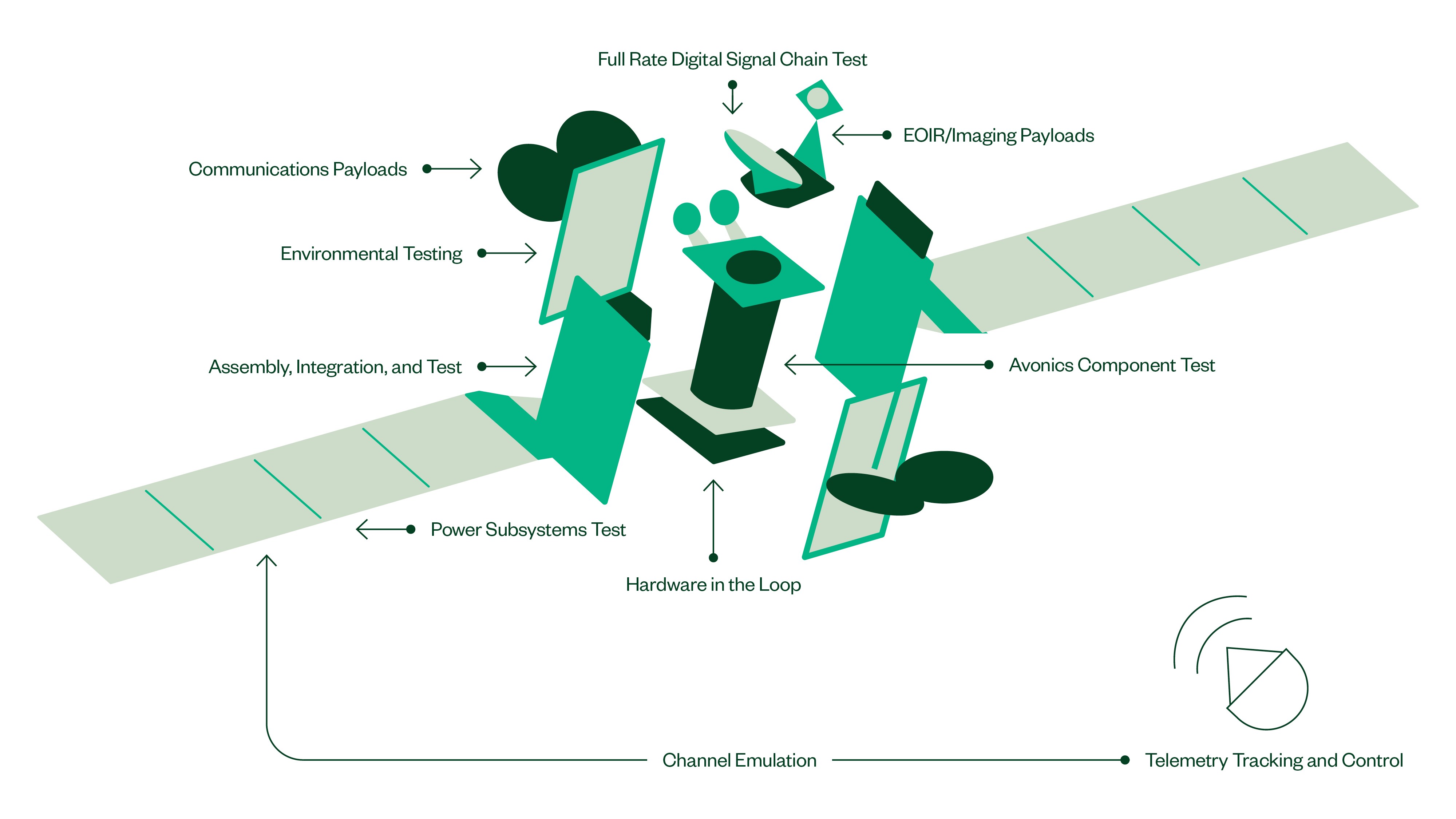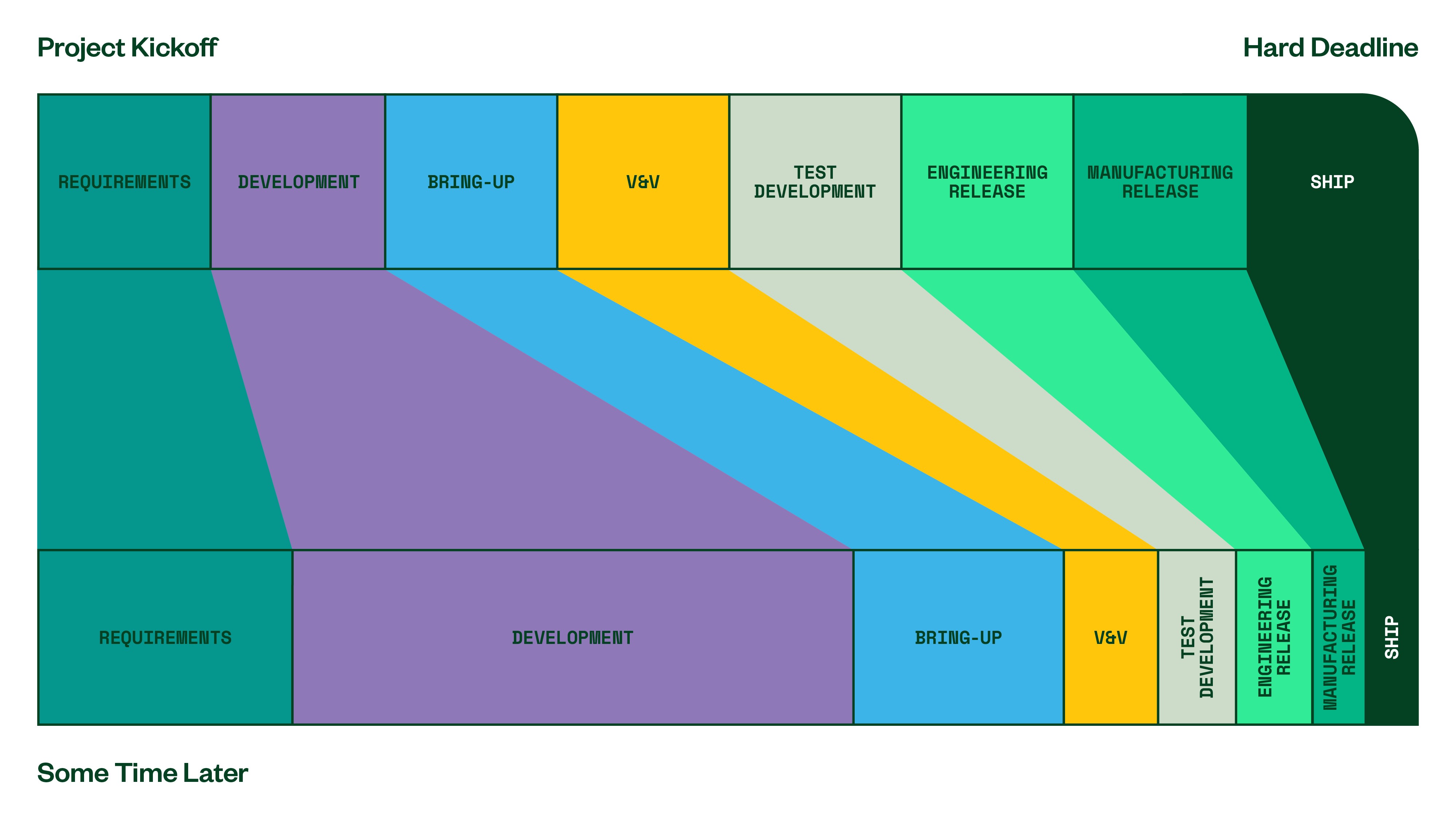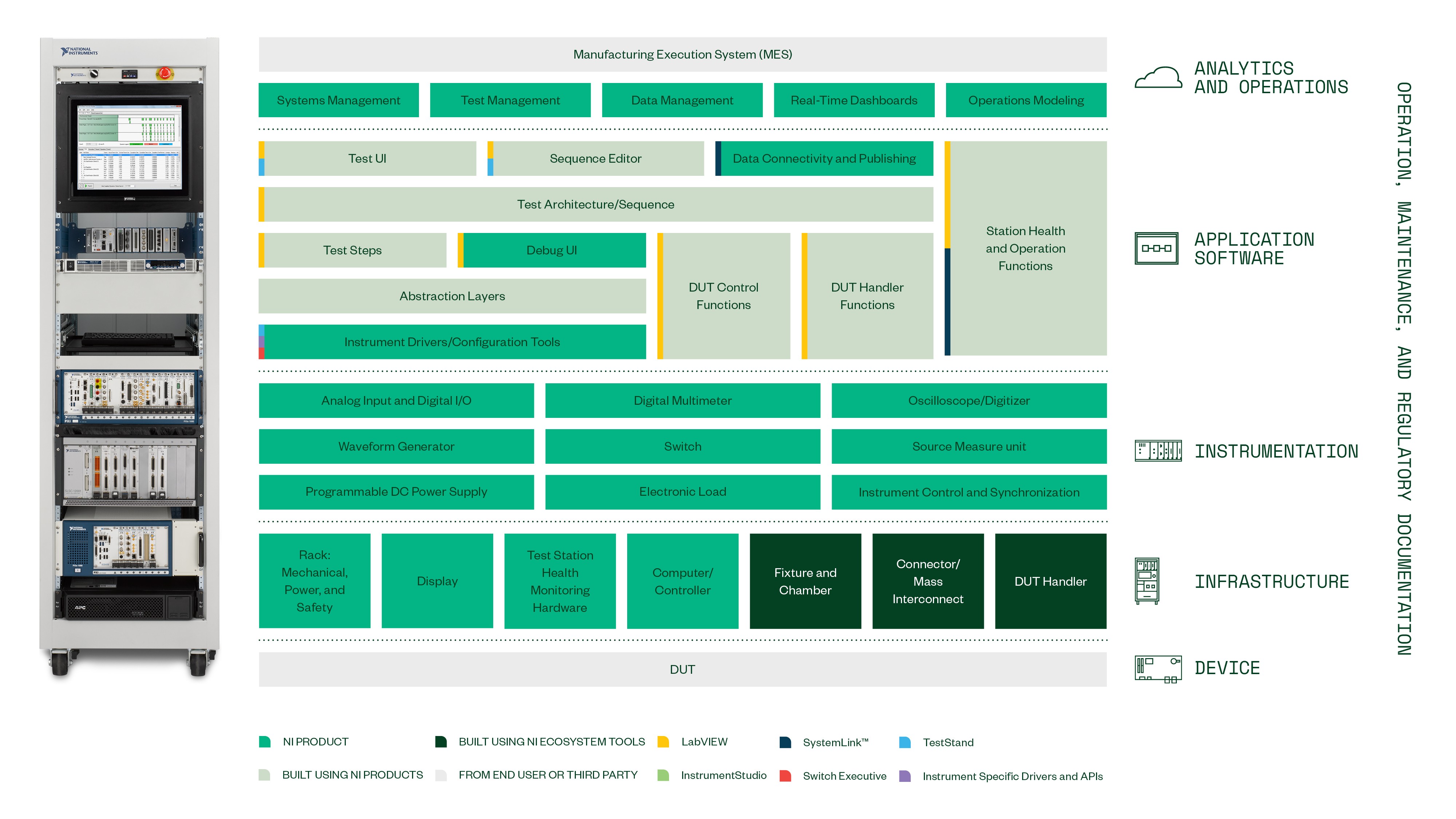Solving Business and Technical Challenges for Satellite Avionics Functional Test
Overview
The accelerated investment in “new space” growth companies has created extreme market pressure to quickly demonstrate flight capability to prove the viability of the business model. At the same time, the traditional space market is responding to increasing demand for capability to launch both defense and scientific missions. These two dynamics are producing exponential growth in the number of satellites as well as shorter timelines to deliver those satellites to market. To meet this new challenge, engineering teams that build and integrate satellites must evolve their approach to test.
The NI solution for avionics test delivers a scalable approach that addresses these new challenges. The modular hardware of the PXI platform with the breadth of high-performance instruments provided by NI can serve the diverse needs of avionics test from component validation through production test into assembly and integration of the full satellite. The interoperability of the NI software suite allows for reuse of IP across multiple projects while the automation capability helps meet demanding schedule requirements. Finally, the data aggregation and analytics of the NI approach allow for optimization of test operations within a project and accelerate the time to market of next-generation designs.
Contents
- Introduction to Satellite Avionics Test
- NI Approach to Satellite Avionics Test
- Conclusion
- Next Steps
Introduction to Satellite Avionics Test
The space industry is undergoing a rapid transformation driven by advancements in technology and a surge in investment by governments, private companies, and other organizations. While countries around the world are investing heavily in space-related programs to the moon, Mars, and beyond, private companies are making significant contributions in reusable rockets and significantly improved access to space. Ultimately, the modern space race is fueled by an unprecedented amount of satellite constellations for applications such as earth observation, global communication, scientific research, and defense.
The evolution of satellite technologies is a key driver of business opportunity, innovation, and technological progress for companies developing satellites. However, this industry transformation also represents a growing number of business and technology challenges that companies and engineering teams must overcome. Core to a satellite are various sensors, avionics subsystems for flight control, power electronics, communication systems, and a unique mission payload. This paper will discuss the critical step of testing satellite avionics systems across the development lifecycle, addressing the technical and business challenges, and ultimately ensuring mission success.
Figure 1: Satellites are composed of various sensors, avionics subsystems, power electronics, communication systems, and a unique mission payload.
Satellite Avionics Test Challenges
Satellite avionics are the components or systems that are responsible for the flight of the satellite and ultimately command and control many of the other satellite systems. Testing the avionics is a critical step in the development and launch of a successful satellite mission. Increased market competitors and more stringent government programs have led to significant cost and timeline pressure for satellite manufacturers. Compared to historical expectations for government programs, modern programs are challenged to reduce costs and deliver avionics components, satellite bus, payload subsystems, and fully integrated satellites across the supply chain in shorter timelines. For New Space companies, time-to-market pressure is ubiquitous, with limited funding and an increase in market entrants. This intense time pressure puts an ever-increasing burden on test organizations; as development delays occur, test teams are expected to reduce their timelines in order to deliver to key schedule dates.
Figure 2: Ideal project timelines compared to reality; as delays occur during development, additional time pressures are put on test organizations.
On the technology side, ensuring reliability and test accuracy is a significant challenge, especially while also staying up to date with the latest advancements in satellite avionics and payload technologies. Given the market shift to low-Earth orbit (LEO) satellites and larger constellation sizes, engineering and manufacturing organizations are also challenged to scale production volumes by one or more orders of magnitude while being constrained by limited resources. To meet these challenges, organizations involved in satellite avionics test must work more closely and efficiently across the product lifecycle, invest in automation technologies, and improve organizational processes to meet their business objectives.
NI Approach to Satellite Avionics Test
The NI approach to satellite avionics test aims to optimize organizational efficiency and improve the quality and reliability of satellites by using integrated hardware and software tools, test automation, and enabling customers to make data a key part of their test strategy. The use of data acquisition, signal conditioning, control systems, and automated test software across the product lifecycle are integral parts of this approach. The goal of the NI approach is to help engineers automate component production test, accelerate assembly, integration, and test (AIT), and shift testing activities earlier in the development process. By incorporating data management and analytics into the test of satellite components and subsystems, it becomes easier and more cost-effective to identify and resolve issues earlier in the development cycle. NI provides a comprehensive solution that streamlines the testing process, helps ensure quality and reliability, and ultimately saves time and cost for satellite manufacturers.
Figure 3: NI’s approach to satellite test aims to optimize organizational efficiency and improve the quality and reliability of satellites by utilizing integrated hardware and software tools, test automation, and enabling customers to incorporate a Design for Test (DFT) strategy.
Using software-defined instruments can reduce overall test equipment costs by enabling reuse of the same equipment and measurement IP across validation and production testing lifecycles. Software-defined instruments provide flexibility in testing by allowing a single piece of equipment to perform multiple functions or standardize hardware across an organization. In addition, software-defined instruments make it easy to automate tests to minimize manual measurements and support growing production volumes. By standardizing and reusing a limited number of test assets, more attention can be focused on automating and enhancing the measurement capabilities, increasing test coverage, and keeping costs low while maintaining flexibility.
High-Performance Parametric Test Instrumentation Selection
Satellite avionics systems interface with virtually every other part of the satellite including mechanical systems and actuators; guidance, navigation, and control (GN&C); and electrical power systems. These interfaces include control signals, sensor signals, navigation and communications signals, and power. The breadth of different signal I/O from the avionics system requires a test solution with a wide variety of instruments and capabilities. NI has an industry-leading selection of data acquisition, control, and electronic instruments in the PXI platform to address all the technical requirements of a modern satellite avionics system. The PXI platform also enables a scalable approach that allows for the addition of more signals as channel count grows or augmentation with new signal types as additional components are integrated into a system. PXI timing and synchronization ensures that the satellite avionics test capability can meet the most demanding technical requirements for performance and scale.
High-Density Instrumentation for Broad Requirements Coverage
Switching has traditionally been used to achieve measurements across large sets of test points, but this can be simplified with high-channel-density instrumentation. For example, not all voltage measurements require DMM accuracy, and high-density data acquisition (DAQ) modules can remove the need for switching within the test system. Instrumentation often has internal switches or high-input impedances, so additional switching to disconnect the instrument from the DUT is not required. High-density I/O also allows for more thorough validation tests, which can identify issues earlier in the program—reducing project timelines and risk. Because of the density and variety of signals involved in satellite avionics, it can be challenging to maximize test coverage while maintaining efficient test times, but the density offered in PXI allows for maximizing test coverage with minimal impact to test time, thereby reducing program risk. Monitoring non-critical channels for unexpected transients with low-cost, high-density channels allows for more thorough coverage without the need to give all pins the same level of scrutiny and test time.
Depending on the DUT being tested, general-purpose I/O may not be adequate to perform some required measurements. To measure these pins/channels, specialized equipment is switched in or external signal conditioning is used. It is ideal to be able to measure all pins/channels simultaneously, which is why signal conditioning is commonly implemented—but doing so often leads to sustainability issues and maintenance. The PXI platform offers modules with common signal conditioning built in to simplify test system design and maintenance. In addition to PXI modules, a companion Switch Load and Signal Conditioning (SLSC) chassis can be leveraged to match to application-specific signal conditioning requirements.
Enabling High-Mix Testing and Scale
NI’s Satellite Avionics Functional Test Solution provides a comprehensive mixed-signal hardware portfolio, measurement abstraction software, fully customizable sequencing engines and automation frameworks, a rack-based test system infrastructure, and space to house additional application-specific hardware. This infrastructure allows for PXI-based test systems to streamline the design, procurement, assembly, and deployment of a mostly integrated test system, which can substantially shorten test development timelines.
In addition, mass interconnects allow for test assets to be leveraged across multiple products and product families without changing the test asset itself. Changes to the interface test adapter (ITA) allow for minimal or no change to expensive test harnesses while reusing the test asset. The use of modular I/O in PXI allows for systems to scale to the number of channels required for the satellite avionics system. This means that the same system designed for one component can be expanded to meet the needs of future programs without the need to procure a new system. These systems can be maintained throughout the program lifecycle from avionics component design, validation, production, and AIT—and hardware can be reused with changes in software to meet different testing needs.
Incorporating Digital Avionics Protocols
In addition to the variety of instrumentation required to functionally test satellite avionics, test systems often require different digital avionics protocols including but not limited to Ethernet, Serial RapidIO®, and SpaceWire. Incorporating these interfaces into a test system often poses significant risk to schedule and maintainability due to the lack of commercial off-the-shelf (COTS) equipment available to meet certain specification requirements. NI offers an approach to help you meet your technical needs by combining the benefits of a COTS solution with those offered by a custom design, without sacrificing the customizability required to meet your technical requirements. Our tools incorporate a user-programmable FPGA for maximum customization to meet your application requirements. Unlike the traditional approach, NI provides a higher-level starting point out of the box, reducing the amount of engineering required for the solution’s creation.
Advanced Automation and Interactive Design Tools
NI’s PXI platform facilitates bring-up, debug, and rapid learning all the way through fully automated characterization to assembly and integration validation testing. Using tools such as NI InstrumentStudio™ software, designers and technicians can interactively troubleshoot their design with familiar instruments, without the need for programming. The underlying software framework allows for the design efforts to be utilized in automated test sequences by exporting measurement parameters that have been previously optimized during the design phase to be reused in later stages of automated testing with tools such as NI TestStand.
Achieving Interoperability across the Lifecycle
A major challenge faced by organizations today is the lack of standardization among suppliers in the use of software frameworks, programming languages, and test automation tools. This becomes particularly problematic during the assembly, integration, and test (AIT) of satellites, as complex tests are performed using ATE from multiple component suppliers. To overcome this challenge, NI has adopted advanced tools and approaches for data sharing and process control, keeping up with the changing needs of customers for interoperability and remote-ability. NI’s Remote-Ability tool leverages gRPC, an open-source, high-performance remote procedure call (RPC) framework, to provide organizations with a simple software interface between their test assets that promotes compatibility across programming languages and environments. By using gRPC, organizations can implement a standard interoperability layer between suppliers and test assets, allowing suppliers to work within their existing workflows and utilize their preferred languages and tools.
Deliver Products Faster with Product Data Insights
Market pressures like accelerated timelines, an increasingly competitive marketplace, evolving satellite and payload complexity, and capital and operational costs can impede efficient execution and the overall success of satellite companies. Utilizing product-centric data strategies that involve connectivity, analytics, and automation can help these organizations maximize the business value of product and process data. Product-centric data strategies incorporate traditional data sources from processes and equipment but also add in other sources such as specifications, design evolution, integration, and especially test. Since product data tracks the result, it remains at the core of product-centric strategies.
As the need for greater operational efficiency arises, Test Operations needs to transform their efforts into increased business value by supplying improved data generation capability. SystemLink™ software connects lab and production test assets, allowing centralized management of systems and the data they produce. Test data can be used to monitor the performance of satellite components and systems throughout the build and integration processes, which can help identify issues or areas that need improvement. By identifying these issues early, satellite companies can avoid the need for design changes, which can add costly delays to schedule. NI’s SystemLink software ecosystem enables companies to employ advanced data management strategies using a software-connected, modern approach to analyzing design and test data, with a focus on meeting the needs of engineers. SystemLink combines NI’s extensive software expertise with new cloud and machine learning technologies, to assist engineers in quickly creating new products and innovations.
Conclusion
The increasing complexity of satellite avionics products is pressuring engineering teams to deliver more intricate test systems while meeting increasingly constrained schedule expectations. These pressures are compounded by a more competitive manufacturing market, where cost savings from operational excellence can be the difference between leading the market and struggling to compete. To combat these pressures, best-in-class engineering groups are standardizing their approaches to test with reusable frameworks of COTS components. This approach helps accelerate development while ensuring future scalability.
NI has been a leader in test for more than 40 years. NI’s platform approach to test combines high-performance instrumentation with test development, sequencing, and management software tools to ensure you meet your specifications, time-to-market schedules, and budgets. NI will support you to standardize your processes, systems, software, and data infrastructure to build a strong foundation for digitalization technology such as analytics, that make best use of your data to improve product and operational performance.


